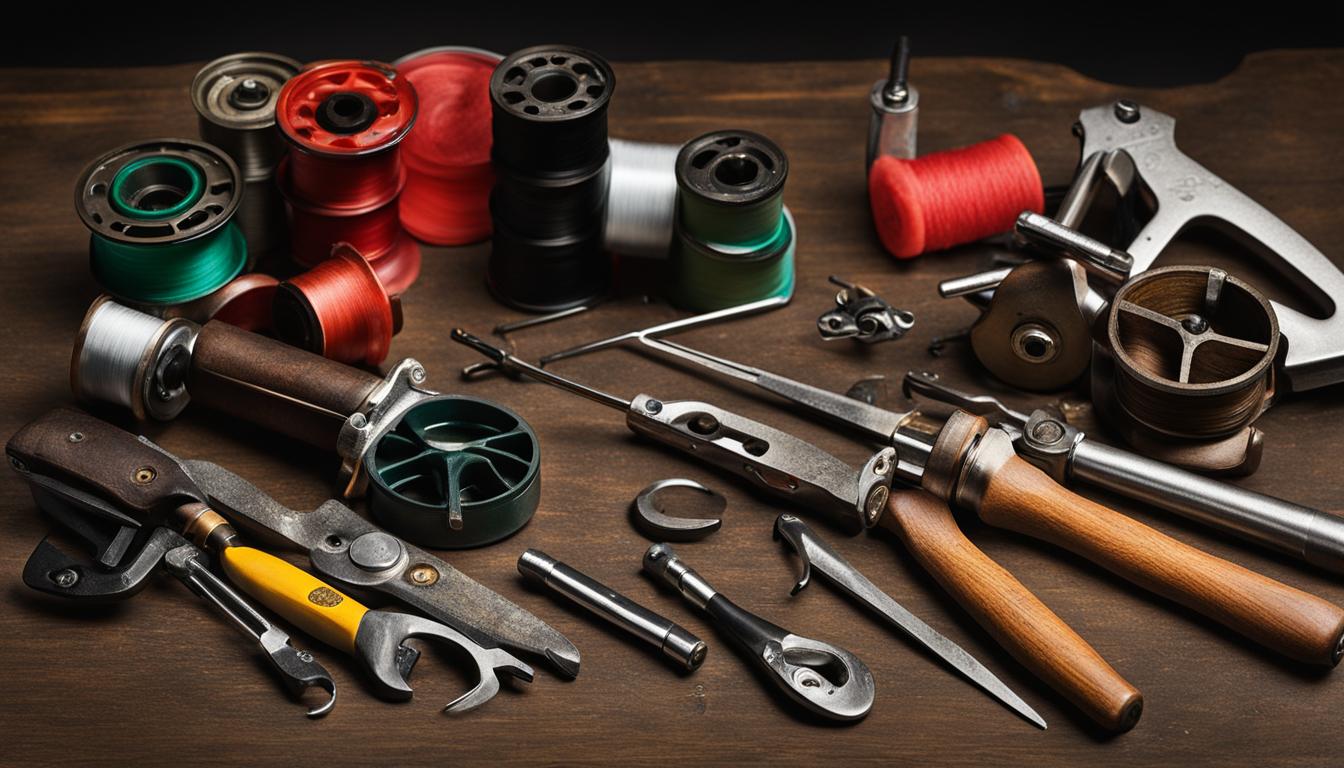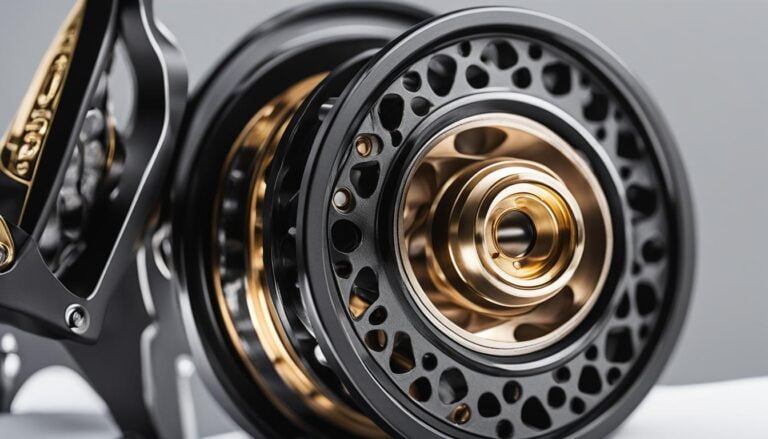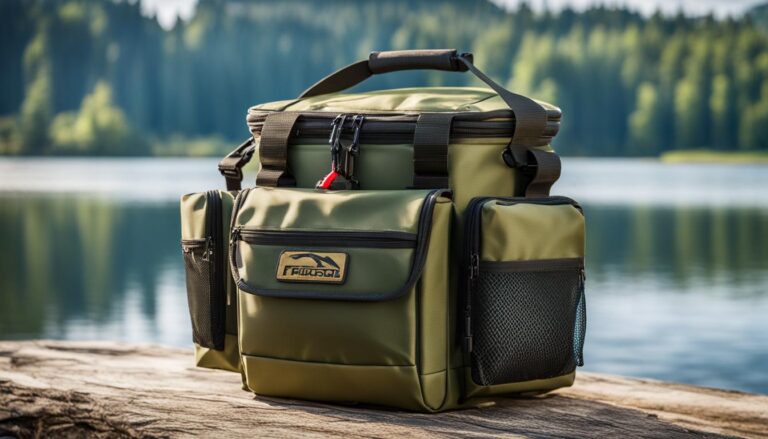Essential Guide to Fishing Reel Repair Tools

Welcome to our essential guide to fishing reel repair tools! In this article, we will provide you with expert advice on the necessary equipment for fishing reel maintenance and servicing. Whether you’re an experienced angler or a beginner, it’s important to have the right tools to keep your fishing reel in top condition. Let’s dive in and explore the world of fishing reel repair tools!
Key Takeaways:
- Fishing reel repair tools are essential for maintaining and servicing your fishing reel.
- Regular maintenance is crucial to ensure the longevity and performance of your reel.
- Daily care involves rinsing your reel with freshwater and removing salt and debris.
- Periodical care includes lubricating the reel and checking/replacing drag washers and springs.
- Seasonal care involves fully disassembling, cleaning, and lubricating your reel’s internal components.
Daily Care for Your Fishing Reel
Proper daily care is essential to ensure the longevity and optimal performance of your fishing reel. By following a few simple steps, you can keep your reel in top condition and prolong its lifespan. Here are some important tips for daily care:
Rinse with Freshwater
After each fishing trip, it’s crucial to rinse your reel with freshwater to remove any salt or debris that may have accumulated. This helps prevent corrosion and keeps the reel functioning smoothly. Use a gentle stream of water to rinse all parts of the reel, including the handle, spool, and bail. Take care not to use high-pressure water, as it can force water into the reel’s internal components.
Remove Salt and Debris
After rinsing, carefully inspect your reel for any remaining salt or debris. Use a soft brush or toothbrush to gently remove any particles from hard-to-reach areas. Pay close attention to the line roller and braid, as dirt or salt build-up in these areas can affect the reel’s performance. Take your time and be thorough to ensure a clean reel.
Dry Thoroughly
Once you have rinsed and cleaned your reel, it’s important to dry it thoroughly before storing it. Use a soft, lint-free cloth to wipe away any remaining moisture. Pay extra attention to the bail, spool, and handle, as these areas are prone to trapping water. Allow your reel to air dry in a cool, dry place to prevent the growth of mold or mildew.
| Tips for Daily Care of Your Fishing Reel |
|---|
| Rinse with Freshwater |
| Rinsing your reel with freshwater after each fishing trip helps remove salt and debris, preventing corrosion and ensuring smooth operation. |
| Remove Salt and Debris |
| Inspect your reel for any remaining salt or debris and use a soft brush or toothbrush to gently remove particles from hard-to-reach areas. |
| Dry Thoroughly |
| After cleaning, dry your reel thoroughly with a soft, lint-free cloth to prevent moisture buildup and the growth of mold or mildew. |

Periodical Care for Your Fishing Reel
In order to keep your fishing reel in optimal condition, it is important to provide regular periodical care. This involves a series of maintenance tasks to ensure smooth operation and longevity. By following the recommended procedures and using the right tools, you can keep your reel performing at its best.
Lubricating the Reel
One crucial step in periodical care is lubricating the moving parts of your fishing reel. This helps reduce friction and prevents wear and tear. Use a high-quality reel lubricant and apply it to the appropriate areas, such as the handle knobs, main gear, and spool shaft. Be careful not to over-lubricate, as this can attract dirt and debris.
Checking and Replacing Parts
Regularly inspect the drag washers, springs, handle grips, and seals of your fishing reel. Over time, these components can become worn or damaged, affecting the reel’s performance. If you notice any signs of wear, it is important to replace these parts with genuine replacements. This will ensure that your reel continues to operate smoothly and efficiently.
Using the Right Tools
When performing periodical care for your fishing reel, it is essential to use the right tools. Invest in a reliable reel repair kit that includes the necessary equipment for maintaining and fixing your reel. This may include screwdrivers, pliers, and specialized tools for specific reel models. Using the proper tools will make the maintenance process easier and more effective.
| Recommended Periodical Care Tasks | Frequency |
|---|---|
| Lubricating the reel | Every 3 months or after heavy use |
| Checking and replacing parts | Every 6 months or as needed |
| Using the right tools | Ongoing |
By following these guidelines for periodical care, you can ensure the smooth operation and longevity of your fishing reel. Regular lubrication, inspection of parts, and the use of the right tools will help you maintain optimal performance and enjoy many successful fishing trips.

Tips for Seasonal Care:
- Store your reel in a cool, dry place away from direct sunlight and extreme temperatures.
- Avoid storing your reel in a tackle box or bag that may have residual moisture.
- If you’re unsure about the disassembly process, consider taking your reel to a professional for seasonal maintenance.
- Regularly inspect your reel throughout the fishing season for any signs of wear, damage, or unusual noise.
- Follow the manufacturer’s recommended maintenance schedule for your specific reel model.
| Component | Task | Frequency |
|---|---|---|
| Gears | Cleaning and lubrication | Seasonal |
| Bearings | Cleaning and lubrication | Seasonal |
| Drag system | Inspection and adjustment | Seasonal |
| Handle | Cleaning and lubrication | Seasonal |
By following these seasonal care tips and incorporating them into your fishing reel maintenance routine, you can ensure that your reel remains in excellent condition and ready for your next fishing adventure.
Components of a Typical Fishing Reel
Understanding the components of a fishing reel is essential for effective repair and maintenance. By familiarizing yourself with the different parts of a typical fishing reel, you can better identify and address any issues that may arise. Let’s take a closer look at these components:
1. Bail
The bail is the metal arm that flips open and closed, allowing the line to be released or retrieved. It helps guide the line onto the spool and prevents it from tangling. The bail is an important component to check for any signs of damage or misalignment.
2. Spool
The spool is where the fishing line is wound and stored. It rotates during casting and retrieving, ensuring smooth line movement. It’s crucial to keep the spool clean and lubricated to prevent friction and ensure proper line management.
3. Drag Washers
The drag washers apply pressure to the spool, allowing you to set the resistance when reeling in a fish. Proper maintenance of the drag washers is essential for smooth and consistent drag performance. Regularly inspect and replace them if necessary.
4. Handle
The handle is used to crank the reel and retrieve the line. It is typically located on the side opposite the bail. The handle should rotate smoothly without any grinding or resistance. Lubricating the handle and its bearings will help maintain its functionality.

Tips for Reel Maintenance and Longevity
Proper maintenance is essential for keeping your fishing reel in optimal condition and ensuring its longevity. By following these tips and using the right fishing reel maintenance equipment, you can extend the lifespan of your reel and enjoy successful fishing adventures for years to come.
1. Rinse with Fresh Water: After every fishing trip, make it a habit to rinse your reel thoroughly with fresh water. This helps remove salt, sand, and other debris that can cause damage or corrosion. Pay special attention to the reel’s exterior, including the handle, spool, and bail.
2. Store Correctly: When not in use, store your fishing reel in a cool, dry place. Avoid exposing it to extreme temperatures, direct sunlight, or excessive humidity. Consider using a reel cover or case to provide additional protection against dust, dirt, and impact.
3. Regular Inspection: Regularly inspect your reel for any signs of wear, damage, or loose parts. Check the bail, drag system, handle, and other components for smooth operation. If you notice any issues, address them promptly to prevent further damage.
4. Use Quality Maintenance Equipment: Invest in high-quality fishing reel maintenance equipment, including cleaning brushes, lubricants, and reel repair kits. Using the right tools ensures effective cleaning and lubrication, allowing your reel to function at its best.
Table: Must-Have Fishing Reel Maintenance Equipment
| Equipment | Description |
|---|---|
| Cleaning Brush | A small brush with soft bristles to remove dirt and debris from the reel’s exterior and interior components. |
| Lubricant | A specialized reel lubricant to reduce friction and protect the reel’s moving parts. |
| Reel Repair Kit | A set of essential tools and replacement parts for repairing minor issues in your fishing reel. |
| Microfiber Cloth | A soft, lint-free cloth for gently wiping down the reel and removing any residual moisture. |
| Reel Grease | A heavy-duty grease for lubricating the reel’s gears and other high-friction areas. |
| Screwdriver Set | A set of precision screwdrivers for removing and tightening screws on the reel’s casing. |
Regular maintenance and proper care are key to maximizing the performance and lifespan of your fishing reel. By incorporating these tips into your routine, you can keep your reel in excellent condition and enjoy many successful fishing experiences.
Conclusion
Regular maintenance and care are essential for keeping your fishing reel in top condition. By following the guidelines and using the right tools, you can ensure the longevity and performance of your reel. Remember to consult the manufacturer’s instructions for specific maintenance procedures and seek professional assistance when needed. With proper care, your fishing reel will continue to provide you with many successful fishing adventures.
FAQ
What tools do I need for fishing reel repair?
You will need tools such as reel cleaning kits, reel maintenance supplies, reel repair kits, and fishing reel part replacements.
How do I take care of my fishing reel on a daily basis?
Daily care includes rinsing your reel with freshwater, removing salt and debris, and drying it thoroughly. Cleaning and maintaining the reel’s line roller and braid is also important.
What does periodical care for a fishing reel involve?
Periodical care includes lubricating the reel, checking and replacing drag washers and springs, and ensuring the proper functioning of handle grips and seals. It is essential to use the right lubricants and parts for your reel.
How do I perform seasonal care for my fishing reel?
Seasonal care involves fully disassembling, cleaning, and lubricating your reel’s internal components. General instructions for this process will be provided, but specific procedures may vary depending on the reel model. Seeking professional assistance is recommended if you are unsure.
What are the main components of a fishing reel?
The main components include the bail, spool, drag washers, and handle. Common problems with these components and how to identify them will also be discussed.
How can I troubleshoot common fishing reel problems?
Step-by-step instructions on fixing problems such as a loose spool, worn-out drag washers, broken bail, and malfunctioning handle will be provided. Reel maintenance supplies and cleaning tools will be used for these repairs.
Can you provide a basic spinning reel maintenance tutorial for beginners?
Yes, we will guide you through the steps of cleaning and lubricating the exterior components of your spinning reel, including the handle, spool, bail, and roller bearings. Regular maintenance is emphasized for optimal performance.
What additional tips can you offer for reel maintenance and longevity?
Rinsing your reel with fresh water after every fishing trip, proper storage, and regular inspection for signs of wear and damage are important. Using high-quality fishing reel maintenance equipment is recommended for optimal performance.
How important is regular maintenance for a fishing reel?
Regular maintenance and care are essential for keeping your fishing reel in top condition. By following the guidelines and using the right tools, you can ensure the longevity and performance of your reel. Remember to consult the manufacturer’s instructions for specific maintenance procedures and seek professional assistance when needed. With proper care, your fishing reel will continue to provide you with many successful fishing adventures.






